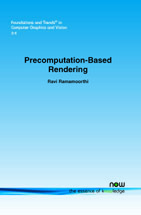Precomputation-Based Rendering
By Ravi Ramamoorthi, University of California at Berkeley, USA, ravir@cs.berkeley.edu
Abstract
High quality image synthesis is a long-standing goal in computer graphics. Complex lighting, reflection, shadow and global illumination effects can be rendered with modern image synthesis algorithms, but those methods are focused on offline computation of a single image. They are far from interactive, and the image must be recomputed from scratch when any aspect of the scene changes. On the other hand, real-time rendering often fixes the object geometry and other attributes, such as relighting a static image for lighting design. In these cases, the final image or rendering is a linear combination of basis images or radiance distributions due to individual lights. We can therefore precompute offline solutions to each individual light or lighting basis function, combining them efficiently for real-time image synthesis. Precomputation-based relighting and radiance transfer has a long history with a spurt of renewed interest, including adoption in commercial video games, due to recent mathematical developments and hardware advances. In this survey, we describe the mathematical foundations, history, current research and future directions for precomputation-based rendering.
Precomputation-Based Rendering
Precomputation-Based Rendering presents a unified mathematical view of precomputation-based rendering, while discussing its motivation, history and current and future research directions. It goes back to some of the early origins of precomputation-based rendering in replaying offline solutions for image relighting. Following this, it describes the new innovations in terms of environment maps and spherical harmonic convolution that inspired the PRT method of Sloan et al. in 2002, the approach that for the first time brought precomputation-based ideas into the mainstream of real-time rendering. It goes on to discuss a number of new innovations in this field over the past six years, to all-frequency effects, changing lighting and view, reflectance editing, dynamic scenes and lighting design.
Precomputation-Based Rendering is an invaluable reference for students and computer graphics researchers. It will also be of interest to professional graphics practitioners.
